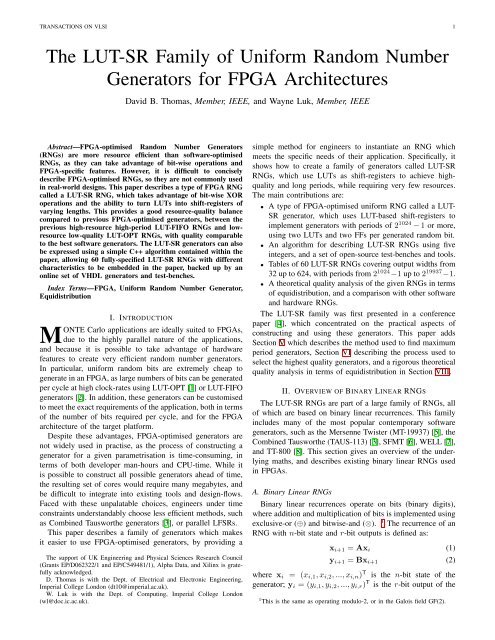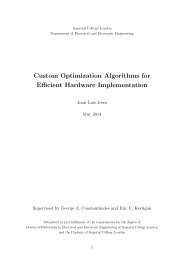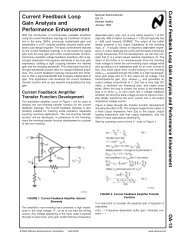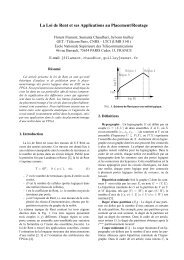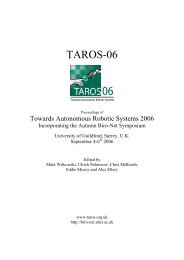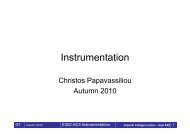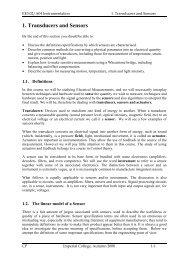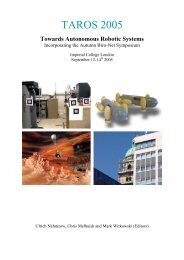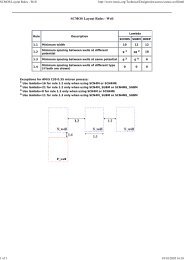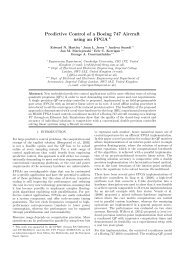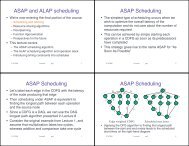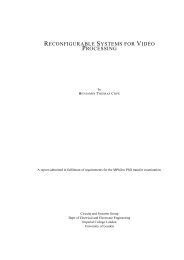The LUT-SR Family of Uniform Random Number Generators for ...
The LUT-SR Family of Uniform Random Number Generators for ...
The LUT-SR Family of Uniform Random Number Generators for ...
You also want an ePaper? Increase the reach of your titles
YUMPU automatically turns print PDFs into web optimized ePapers that Google loves.
TRANSACTIONS ON VLSI 1<br />
<strong>The</strong> <strong>LUT</strong>-<strong>SR</strong> <strong>Family</strong> <strong>of</strong> <strong>Uni<strong>for</strong>m</strong> <strong>Random</strong> <strong>Number</strong><br />
<strong>Generators</strong> <strong>for</strong> FPGA Architectures<br />
David B. Thomas, Member, IEEE, and Wayne Luk, Member, IEEE<br />
Abstract—FPGA-optimised <strong>Random</strong> <strong>Number</strong> <strong>Generators</strong><br />
(RNGs) are more resource efficient than s<strong>of</strong>tware-optimised<br />
RNGs, as they can take advantage <strong>of</strong> bit-wise operations and<br />
FPGA-specific features. However, it is difficult to concisely<br />
describe FPGA-optimised RNGs, so they are not commonly used<br />
in real-world designs. This paper describes a type <strong>of</strong> FPGA RNG<br />
called a <strong>LUT</strong>-<strong>SR</strong> RNG, which takes advantage <strong>of</strong> bit-wise XOR<br />
operations and the ability to turn <strong>LUT</strong>s into shift-registers <strong>of</strong><br />
varying lengths. This provides a good resource-quality balance<br />
compared to previous FPGA-optimised generators, between the<br />
previous high-resource high-period <strong>LUT</strong>-FIFO RNGs and lowresource<br />
low-quality <strong>LUT</strong>-OPT RNGs, with quality comparable<br />
to the best s<strong>of</strong>tware generators. <strong>The</strong> <strong>LUT</strong>-<strong>SR</strong> generators can also<br />
be expressed using a simple C++ algorithm contained within the<br />
paper, allowing 60 fully-specified <strong>LUT</strong>-<strong>SR</strong> RNGs with different<br />
characteristics to be embedded in the paper, backed up by an<br />
online set <strong>of</strong> VHDL generators and test-benches.<br />
Index Terms—FPGA, <strong>Uni<strong>for</strong>m</strong> <strong>Random</strong> <strong>Number</strong> Generator,<br />
Equidistribution<br />
I. INTRODUCTION<br />
MONTE Carlo applications are ideally suited to FPGAs,<br />
due to the highly parallel nature <strong>of</strong> the applications,<br />
and because it is possible to take advantage <strong>of</strong> hardware<br />
features to create very efficient random number generators.<br />
In particular, uni<strong>for</strong>m random bits are extremely cheap to<br />
generate in an FPGA, as large numbers <strong>of</strong> bits can be generated<br />
per cycle at high clock-rates using <strong>LUT</strong>-OPT [1] or <strong>LUT</strong>-FIFO<br />
generators [2]. In addition, these generators can be customised<br />
to meet the exact requirements <strong>of</strong> the application, both in terms<br />
<strong>of</strong> the number <strong>of</strong> bits required per cycle, and <strong>for</strong> the FPGA<br />
architecture <strong>of</strong> the target plat<strong>for</strong>m.<br />
Despite these advantages, FPGA-optimised generators are<br />
not widely used in practise, as the process <strong>of</strong> constructing a<br />
generator <strong>for</strong> a given parametrisation is time-consuming, in<br />
terms <strong>of</strong> both developer man-hours and CPU-time. While it<br />
is possible to construct all possible generators ahead <strong>of</strong> time,<br />
the resulting set <strong>of</strong> cores would require many megabytes, and<br />
be difficult to integrate into existing tools and design-flows.<br />
Faced with these unpalatable choices, engineers under time<br />
constraints understandably choose less efficient methods, such<br />
as Combined Tausworthe generators [3], or parallel LF<strong>SR</strong>s.<br />
This paper describes a family <strong>of</strong> generators which makes<br />
it easier to use FPGA-optimised generators, by providing a<br />
<strong>The</strong> support <strong>of</strong> UK Engineering and Physical Sciences Research Council<br />
(Grants EP/D062322/1 and EP/C549481/1), Alpha Data, and Xilinx is gratefully<br />
acknowledged.<br />
D. Thomas is with the Dept. <strong>of</strong> Electrical and Electronic Engineering,<br />
Imperial College London (dt10@imperial.ac.uk).<br />
W. Luk is with the Dept. <strong>of</strong> Computing, Imperial College London<br />
(wl@doc.ic.ac.uk).<br />
simple method <strong>for</strong> engineers to instantiate an RNG which<br />
meets the specific needs <strong>of</strong> their application. Specifically, it<br />
shows how to create a family <strong>of</strong> generators called <strong>LUT</strong>-<strong>SR</strong><br />
RNGs, which use <strong>LUT</strong>s as shift-registers to achieve highquality<br />
and long periods, while requiring very few resources.<br />
<strong>The</strong> main contributions are:<br />
• A type <strong>of</strong> FPGA-optimised uni<strong>for</strong>m RNG called a <strong>LUT</strong>-<br />
<strong>SR</strong> generator, which uses <strong>LUT</strong>-based shift-registers to<br />
implement generators with periods <strong>of</strong> 2 1024 − 1 or more,<br />
using two <strong>LUT</strong>s and two FFs per generated random bit.<br />
• An algorithm <strong>for</strong> describing <strong>LUT</strong>-<strong>SR</strong> RNGs using five<br />
integers, and a set <strong>of</strong> open-source test-benches and tools.<br />
• Tables <strong>of</strong> 60 <strong>LUT</strong>-<strong>SR</strong> RNGs covering output widths from<br />
32 up to 624, with periods from 2 1024 −1 up to 2 19937 −1.<br />
• A theoretical quality analysis <strong>of</strong> the given RNGs in terms<br />
<strong>of</strong> equidistribution, and a comparison with other s<strong>of</strong>tware<br />
and hardware RNGs.<br />
<strong>The</strong> <strong>LUT</strong>-<strong>SR</strong> family was first presented in a conference<br />
paper [4], which concentrated on the practical aspects <strong>of</strong><br />
constructing and using these generators. This paper adds<br />
Section V which describes the method used to find maximum<br />
period generators, Section VI describing the process used to<br />
select the highest quality generators, and a rigorous theoretical<br />
quality analysis in terms <strong>of</strong> equidistribution in Section VIII.<br />
II. OVERVIEW OF BINARY LINEAR RNGS<br />
<strong>The</strong> <strong>LUT</strong>-<strong>SR</strong> RNGs are part <strong>of</strong> a large family <strong>of</strong> RNGs, all<br />
<strong>of</strong> which are based on binary linear recurrences. This family<br />
includes many <strong>of</strong> the most popular contemporary s<strong>of</strong>tware<br />
generators, such as the Mersenne Twister (MT-19937) [5], the<br />
Combined Tausworthe (TAUS-113) [3], SFMT [6], WELL [7],<br />
and TT-800 [8]. This section gives an overview <strong>of</strong> the underlying<br />
maths, and describes existing binary linear RNGs used<br />
in FPGAs.<br />
A. Binary Linear RNGs<br />
Binary linear recurrences operate on bits (binary digits),<br />
where addition and multiplication <strong>of</strong> bits is implemented using<br />
exclusive-or (⊕) and bitwise-and (⊗). 1 <strong>The</strong> recurrence <strong>of</strong> an<br />
RNG with n-bit state and r-bit outputs is defined as:<br />
x i+1 = Ax i (1)<br />
y i+1 = Bx i+1 (2)<br />
where x i = (x i,1 , x i,2 , ..., x i,n ) T is the n-bit state <strong>of</strong> the<br />
generator; y i = (y i,1 , y i,2 , ..., y i,r ) T is the r-bit output <strong>of</strong> the<br />
1 This is the same as operating modulo-2, or in the Galois field GF(2).
TRANSACTIONS ON VLSI 2<br />
generator; A is an n × n binary transition matrix; and B is<br />
an r × n binary output matrix. Because the state is finite, and<br />
the recurrence is deterministic, eventually the state sequence<br />
x 0 , x 1 , x 2 , ... must start to repeat.<br />
<strong>The</strong> minimum value p such that x i+p = x i is called the<br />
period <strong>of</strong> the generator, and one goal in designing random<br />
number generators is to achieve the maximum period <strong>of</strong><br />
p = 2 n − 1; a period <strong>of</strong> 2 n cannot be achieved because<br />
it is impossible to choose A such that x 0 = 0 maps to<br />
anything other than x 1 = 0. This leads to two sequences in a<br />
maximum period generator: a degenerate sequence <strong>of</strong> length<br />
one which contains only zero, and the main sequence which<br />
iterates through every possible non-zero n-bit pattern be<strong>for</strong>e<br />
repeating. A necessary and sufficient condition <strong>for</strong> a generator<br />
to have maximum period is that the characteristic polynomial<br />
P (z) <strong>of</strong> the transition matrix A must be primitive [1].<br />
<strong>The</strong> matrix B is used to trans<strong>for</strong>m the internal RNG state<br />
into the random output bits produced by the generator. In the<br />
simplest case we have r = n and B = I, which means the<br />
state bits are used directly as random output bits, but in many<br />
generators most <strong>of</strong> the internal state bits are not sufficiently<br />
random. In these cases r < n, and either some state bits are<br />
not propagated through to the output, or multiple state bits are<br />
XOR’d together to produce each output bit.<br />
<strong>The</strong> quality <strong>of</strong> a generators is measured in two ways:<br />
empirical tests, which look at generated sequences <strong>of</strong> numbers;<br />
and theoretical tests, which considered mathematical properties<br />
<strong>of</strong> the entire number sequence. Examples <strong>of</strong> empirical<br />
tests are to track the distribution <strong>of</strong> ones versus zeros, or to<br />
examine the Fourier trans<strong>for</strong>m <strong>of</strong> the uni<strong>for</strong>m sequence, and<br />
to see if the observed behaviour deviates significantly from<br />
the behaviour <strong>of</strong> an ideal uni<strong>for</strong>m source. Many such tests are<br />
gathered into batteries such as TestU01 [9], which examine<br />
long output sequences from a given RNG to find evidence <strong>of</strong><br />
non-randomness.<br />
<strong>The</strong>oretical randomness <strong>of</strong> binary linear generators is measured<br />
using equidistribution [3], which describes how evenly<br />
distributed the output sequence is in multiple dimensions.<br />
Equidistribution is defined in terms <strong>of</strong> a resolution l, which is<br />
the number <strong>of</strong> most-significant bits considered from the output,<br />
and a dimension d, which is the number <strong>of</strong> consecutive output<br />
samples. If a generator is (d, l)-distributed then every possible<br />
length d sequence will be observed in the output sequence the<br />
same number <strong>of</strong> times. For example, if a 32-bit generator is<br />
(3, 16)-distributed then all possible 16-bit output triples will be<br />
equally likely. Alternatively, if a generator is (d, r)-distributed,<br />
i.e. it is equidistributed to d dimensions over the output bitwidth,<br />
and it is initialised to an unknown random state x 0 ,<br />
then observing y 1 ..y d−1 gives no in<strong>for</strong>mation at all about what<br />
y d will be. However, observing y 1 ..y d may allow us to make<br />
predictions about the value <strong>of</strong> y d+1 , or in some cases allow<br />
us to predict it precisely.<br />
<strong>The</strong>re are three stages when designing such a generator:<br />
1) Describe a family <strong>of</strong> generators G F , such that each<br />
member <strong>of</strong> G F can be efficiently implemented in the<br />
target architecture. However, only some members <strong>of</strong> G F<br />
will have the maximum period property.<br />
2) Extract a maximum period subset G M ⊂ G F , such<br />
that all members <strong>of</strong> G M implement a matrix A with<br />
a primitive characteristic polynomial. This is achieved<br />
either by randomly selecting and testing members <strong>of</strong><br />
G F , or by exhaustive enumeration if |G F | is small.<br />
3) Find the generator g I ∈ G M which produces the<br />
output stream with highest statistical quality, either by<br />
considering multiple members with different A matrices,<br />
or by trying many different B matrices <strong>for</strong> a single<br />
transition matrix.<br />
<strong>The</strong> selected RNG instance g I ∈ G F can then be expressed<br />
as code (e.g. C or VHDL) and used in the target architecture.<br />
B. <strong>LUT</strong>-Optimised RNGs<br />
<strong>LUT</strong>-optimised (<strong>LUT</strong>-OPT) generators [1] are a family <strong>of</strong><br />
generators with a matrix A where each row and column<br />
contains t − 1 or t ones. In hardware terms this means that<br />
each row maps to a t − 1 or t-input XOR gate, and so can<br />
be implemented in a single t-input <strong>LUT</strong>. Thus if the current<br />
vector state is held in a register, each bit <strong>of</strong> the new vector<br />
state can be calculated in a single <strong>LUT</strong>, and an r-bit generator<br />
can be implemented in r fully-utilised <strong>LUT</strong>-FFs. <strong>The</strong> basic<br />
structure <strong>of</strong> a <strong>LUT</strong>-OPT generator is shown in Figure 1 (a).<br />
A simple example <strong>of</strong> a maximum period <strong>LUT</strong>-OPT generator<br />
with r = 6 and t = 3 is given by the recurrence:<br />
⎡<br />
⎤<br />
0 1 1 0 0 0<br />
0 1 1 0 0 1<br />
0 1 0 1 0 0<br />
A =<br />
⎢1 0 0 0 1 0<br />
,<br />
⎥<br />
⎣1 0 0 0 0 1⎦<br />
1 0 0 1 1 0<br />
⎡ ⎤ ⎡<br />
x i+1,1<br />
x i+1,2<br />
x i+1,3<br />
⎢x =<br />
i+1,4 ⎥ ⎢<br />
⎣x i+1,5<br />
⎦ ⎣<br />
x i+1,6<br />
x i,2 ⊕ x i,3<br />
x i,2 ⊕ x i,3 ⊕ x i,6<br />
x i,2 ⊕ x i,4<br />
x i,1 ⊕ x i,5<br />
x i,1 ⊕ x i,6<br />
x i,1 ⊕ x i,4 ⊕ x i,5<br />
Such matrices can be found <strong>for</strong> all t ≥ 3 and r ≥ 4, and are<br />
practical <strong>for</strong> generating up to ∼ 1000 uni<strong>for</strong>m bits per cycle.<br />
<strong>LUT</strong>-OPT generators have two key advantages:<br />
• Resource efficiency: each additional bit requires one<br />
additional <strong>LUT</strong> and FF, so resource usage scales linearly<br />
- generating r bits per cycle requires r <strong>LUT</strong>-FFs.<br />
• Per<strong>for</strong>mance: the critical path in terms <strong>of</strong> logic is a single<br />
<strong>LUT</strong> delay, so the generators are extremely fast: usually<br />
the clock net is the limiting factor, with routing delay and<br />
congestion only becoming a factor <strong>for</strong> large n.<br />
However, these advantages are balanced by a number <strong>of</strong><br />
disadvantages:<br />
1) Complexity: Each (r, t) combination requires a unique<br />
matrix <strong>of</strong> connections, which must be found using<br />
specialised s<strong>of</strong>tware. If these matrices are randomly<br />
constructed (as in previous work), then it is difficult to<br />
compactly encode these matrices, so it is difficult <strong>for</strong><br />
FPGA engineers to make use <strong>of</strong> the RNGs.<br />
2) Quality: <strong>The</strong> random bits are <strong>for</strong>med as a linear combination<br />
<strong>of</strong> random bits produced in the previous cycle -<br />
when t = 3 some <strong>of</strong> the new bits will be a simple 2-<br />
input XOR <strong>of</strong> bits from the previous cycle. <strong>The</strong> impact<br />
<strong>of</strong> this lag-1 linear dependence is minimal in modern<br />
FPGAs where t ≥ 5, and also diminishes quickly as r<br />
is increased, but remains a source <strong>of</strong> concern.<br />
3) Period: In order to achieve a period <strong>of</strong> 2 n − 1 it is<br />
necessary to choose r = n, even if far fewer than n bits<br />
⎤<br />
⎥<br />
⎦
TRANSACTIONS ON VLSI 3<br />
k<br />
w<br />
r<br />
r<br />
k k 1 k4<br />
r<br />
(a) <strong>LUT</strong>-OPT<br />
n=r | p=2 n<br />
(b) <strong>LUT</strong>-FIFO<br />
n=r+kw | p=2 n<br />
(c) FIFO <strong>of</strong> <strong>LUT</strong>-OPTs<br />
n=r(1+k) | p=2 r (1+k)<br />
(d) <strong>LUT</strong>-<strong>SR</strong><br />
n
TRANSACTIONS ON VLSI 4<br />
one per output bit, increasing the potential state to n = r(1 +<br />
k). If we assume k = 32 (as found in modern FPGAs), and a<br />
modest RNG output width <strong>of</strong> r = 32, the state size increases<br />
to n = 1056. This provides a potential period <strong>of</strong> 2 1056 − 1 <strong>for</strong><br />
a cost <strong>of</strong> 64 <strong>LUT</strong>s, as compared to a period <strong>of</strong> 2 64 − 1 <strong>for</strong> a<br />
<strong>LUT</strong> optimised generator with the same resource usage.<br />
It might be tempting to simply configure all shift-registers<br />
with the same length, in an attempt to maximise the period<br />
<strong>for</strong> a given number <strong>of</strong> resources, but this cannot provide a<br />
maximum period generator. Instead it would result in 1 + k<br />
independent r-bit generators, with a sample taken from each<br />
on successive cycles, shown in Figure 1 (c). In <strong>LUT</strong>-FIFO<br />
generators this problem is avoided by making each new output<br />
bit dependent on one bit from the previous cycle, with the<br />
remaining t − 1 or t − 2 bits provided by the FIFO output.<br />
This lag-1 dependency is not ideal, but is generally benign as<br />
the <strong>LUT</strong>-FIFO uses deep block-RAM based FIFOs.<br />
Bit-wide shift-registers enable a different solution which<br />
allows large periods to be achieved, while also improving<br />
the rate <strong>of</strong> mixing within the generator state. Each <strong>of</strong> the r<br />
shift-registers can be assigned some specific length k i ≤ k,<br />
reducing the state size to n = ∑ r<br />
i=1 (1 + k i). One solution<br />
would be to randomly configure each shift-register as k i = k<br />
or k i = k −1, giving a period rk < n < r(1+k). But a much<br />
more interesting solution is to randomly choose 1 < k i ≤ k,<br />
subject to the constraint ∃i, j : i ≠ j ∧gcd(k i +1, k j +1) = 1.<br />
This allows <strong>for</strong> much more rapid mixing between bits within<br />
the state, while still providing necessary (but not sufficient)<br />
conditions <strong>for</strong> mixing within the state.<br />
Part (d) <strong>of</strong> Figure 1 shows the new <strong>LUT</strong>-<strong>SR</strong> style <strong>of</strong><br />
generator. All four generators shown in the figure may seem<br />
superficially similar, but actually provide quite different trade<strong>of</strong>fs<br />
in terms <strong>of</strong> quality vs. resource usage.<br />
Both the <strong>LUT</strong>-OPT and <strong>LUT</strong>-FIFO RNGs were originally<br />
developed and presented without much consideration <strong>of</strong> how<br />
to initialise the generator state. Initialisation is very important,<br />
as it is common to instantiate multiple parallel RNGs implementing<br />
the same algorithm, and each must be initialised with<br />
a distinct seed (initial state vector).<br />
Given an l-input <strong>LUT</strong>s, we can implement a t = l <strong>LUT</strong>optimised<br />
RNG, but there is no way to read or write the RNG<br />
state. 2 Loading the state in parallel only allows a t = l − 2<br />
RNG, as one <strong>LUT</strong> input is needed to select when to load,<br />
and the other is needed to provide the new 1-bit value. In a<br />
4-<strong>LUT</strong> architecture, this implies t = 2, which is not possible<br />
(some bits would be direct copies <strong>of</strong> bits from the previous<br />
cycle), so two <strong>LUT</strong>s per bit would be needed. Parallel loading<br />
also means that the RNG initialisation circuitry (which is only<br />
needed at the start <strong>of</strong> simulations, and so should be as small as<br />
possible) must contain O(r) resources, so even in the best-case<br />
the resources per RNG have doubled.<br />
A better approach is to find a cycle through the matrix A,<br />
and use this to implement a 1-bit shift-register through the<br />
RNG. This only requires one bit per <strong>LUT</strong> (to select between<br />
RNG and load mode), so allows t = l − 1, requiring only<br />
one <strong>LUT</strong> per bit in a 4-<strong>LUT</strong> architecture, and allowing an<br />
2 Excluding device-specific FF read/write chains, such as provided in Stratix.<br />
mode<br />
= 0<br />
Fig. 2.<br />
mode<br />
= 0<br />
state_out<br />
state_in<br />
state_out<br />
state_in<br />
r[3:0]<br />
r[3:0]<br />
mode<br />
= 1<br />
mode<br />
= 1<br />
state_out<br />
state_in<br />
state_in<br />
r[3:0]<br />
r[3:0]<br />
Normal versus load paths <strong>for</strong> serial seeding <strong>of</strong> RNGs.<br />
efficient serial initialisation circuit, no matter how large r is.<br />
This approach can be extended to the <strong>LUT</strong>-FIFO RNG as well,<br />
as in any maximum period generator there must exist a cycle<br />
running through all state bits in the RNG.<br />
However, if the matrix A is randomly chosen, we must find<br />
a Hamiltonian cycle through a sparse graph <strong>of</strong> n points to<br />
determine the shift-register path. <strong>The</strong> original <strong>LUT</strong>-OPT paper<br />
correctly notes that this is possible, but even <strong>for</strong> reasonable<br />
values <strong>of</strong> n it can become computationally infeasible. In<br />
defining the <strong>LUT</strong>-<strong>SR</strong> generators, the provision <strong>of</strong> a serial load<br />
chain is explicitly taken into account, by embedding a chosen<br />
cycle into the matrix A from the start.<br />
Specifically, we embed a very simply cycle <strong>of</strong> the <strong>for</strong>m<br />
i ← (i + 1) mod r through the XOR bits, shown in Figure 2.<br />
This simple cycle trivially extends through the shift-registers,<br />
and allows switching between the RNG and load modes using<br />
one input bit per <strong>LUT</strong>.<br />
Including such a simple cycle in the generators could cause<br />
statistical problems <strong>for</strong> generators when t = 3, as there will<br />
be a simple linear dependence between adjacent output bits in<br />
cycles at a fixed lag. In an attempt to minimise this effect, an<br />
output permutation can be applied, to mix up the bits.<br />
IV. ALGORITHM FOR DESCRIBING <strong>LUT</strong>-<strong>SR</strong> GENERATORS<br />
<strong>The</strong> broad class <strong>of</strong> <strong>LUT</strong>-<strong>SR</strong> generators as described is<br />
very general, and it is possible to construct a huge number<br />
<strong>of</strong> candidate <strong>LUT</strong>-<strong>SR</strong> RNGs by randomly generating binary<br />
matrices which meet the requirements. However, this presents<br />
the problem <strong>of</strong> communicating and disseminating RNGs experienced<br />
with <strong>LUT</strong>-OPT and <strong>LUT</strong>-FIFO papers: the matrices are<br />
far too large and complicated to be included in a publication,<br />
so must be provided separately from the paper. Instead the<br />
<strong>LUT</strong>-<strong>SR</strong> generator family uses a short but precise algorithm <strong>for</strong><br />
expanding a tuple <strong>of</strong> five integers into the full RNG structure.<br />
<strong>The</strong> algorithm takes as input a 5-tuple (n, r, t, k, s):
TRANSACTIONS ON VLSI 5<br />
n <strong>Number</strong> <strong>of</strong> state bits in the RNG (period is 2 n − 1).<br />
r <strong>Number</strong> <strong>of</strong> random output bits generated per cycle.<br />
t XOR gate input count.<br />
k Maximum shift-register length.<br />
s Free parameter used to select a specific generator.<br />
<strong>The</strong> first four parameters (n, r, t, k) describe the properties<br />
<strong>of</strong> the generator in terms <strong>of</strong> application requirements and<br />
architectural restrictions. <strong>The</strong> final parameter s is used to select<br />
from amongst one <strong>of</strong> 2 32 candidates that the algorithm can<br />
produce with the chosen values <strong>of</strong> (n, r, t, k).<br />
Note: arbitrary values <strong>of</strong> s will not result in a valid RNG;<br />
the choice <strong>of</strong> s is critically dependent on (n, r, t, k), and<br />
modifying one or more components will break the generator.<br />
Please only use the tuples listed later in the paper.<br />
Listing 1 gives the expansion algorithm and RNG as a C++<br />
class - the constructor takes a 5-tuple <strong>of</strong> RNG parameters<br />
and expands them into a complete description <strong>of</strong> the RNG,<br />
the “PrintConnections” function can then print an RTL style<br />
description <strong>of</strong> the RNG, while the “Step” function provides a<br />
s<strong>of</strong>tware reference implementation.<br />
<strong>The</strong> constructor expands the RNG using five stages:<br />
1) Create initial seed cycle: A cycle <strong>of</strong> length r is created<br />
through the r XOR-gates at the output <strong>of</strong> the RNG. At<br />
this stage there are no FIFO bits, or equivalently there<br />
are r FIFOs <strong>of</strong> length 0.<br />
2) FIFO extension: the cycle is randomly extended until a<br />
total cycle length <strong>of</strong> n is reached, by randomly selecting<br />
a FIFO and increasing its length by 1, while maintaining<br />
the known cycle.<br />
3) Add loading connections: the known cycle is added to<br />
the graph “taps”, which describes the matrix A. <strong>The</strong><br />
cycle describes the FIFO connections completely, and<br />
also describes the first input to each <strong>of</strong> the r XOR gates.<br />
4) Add XOR connections: the cycle provides one input <strong>for</strong><br />
each <strong>of</strong> the XOR gates, so now the additional t − 1<br />
random inputs are added over t − 1 rounds. Each round<br />
is constructed from a permutation <strong>of</strong> the FIFO outputs,<br />
which ensures that at the end each FIFO output is used<br />
at most t times. Some bits will be assigned the same<br />
FIFO bit in multiple rounds, and so will have fewer than<br />
t inputs: this is critical to achieve a maximum period<br />
generator, and also provides us with an entry point into<br />
the cycle <strong>for</strong> seed loading.<br />
5) Output permutation: the simple dependency between<br />
adjacent bits is masked using a final output permutation.<br />
After construction, the RNG structure can be printed as<br />
RTL-style C using the function “PrintConnections”. For example,<br />
the input tuple (n = 12, r = 4, t = 3, k = 3, s = 0x4d)<br />
describes a generator with period 2 12 −1, producing 4 random<br />
bits per cycle, with a maximum <strong>of</strong> 3 inputs per XOR gate,<br />
and a maximum FIFO depth <strong>of</strong> 3. <strong>The</strong> re-<strong>for</strong>matted and<br />
commented output is shown in Figure 3;<br />
Due to the very simple printing code the <strong>for</strong>mat is not very<br />
pretty, but this describes a generator in terms <strong>of</strong> six variables:<br />
ns,cs<br />
: cs is the current state <strong>of</strong> the generator, and ns is<br />
the next state <strong>of</strong> the generator. Both are n bit vectors,<br />
and describe both the FF and FIFO state.<br />
Listing 1. Source code <strong>for</strong> decoding generators<br />
struct rng{<br />
static int LCG(uint32_t &s) // Simple LCG RNG<br />
{ return (s=1664525UL*s+1013904223UL)>>16; }<br />
static void Permute(uint32_t &s, vector &p)<br />
{ <strong>for</strong>(int j=p.size();j>1;j--) swap(p[j-1],p[LCG(s)%j]); }<br />
int n, r, t, maxk; // rng parameters<br />
uint32_t s; // Seed <strong>for</strong> generator<br />
vector taps; // connections<br />
vector cycle; // cycle through bits<br />
vector perm; // output permutation<br />
int seedTap; // Entry point to cycle<br />
rng(int _n, int _r, int _t, int _maxk, uint32_t _s)<br />
: n(_n), r(_r), t(_t), maxk(_maxk), s(_s)<br />
, taps(n), cycle(n), perm(r), seedTap(0)<br />
{ // Construct an rng using (n,r,t,maxk,s) tuple<br />
vector outputs(r), len(r,0); int bit;<br />
// 1: Create cycle through bits <strong>for</strong> seed loading<br />
<strong>for</strong>(int i=0;i
TRANSACTIONS ON VLSI 6<br />
// Sequential update <strong>of</strong> registers using XOR gates<br />
ns[0]= m?s_in :(0ˆcs[9]ˆcs[10]); // Load chain input<br />
ns[1]= m?cs[6] :(0ˆcs[6]ˆcs[11]);<br />
ns[2]= m?cs[11]:(0ˆcs[6]ˆcs[10]ˆcs[11]);<br />
ns[3]= m?cs[9] :(0ˆcs[9]ˆcs[10]ˆcs[11]);<br />
// Sequential update <strong>of</strong> internal Shift-Register bits<br />
ns[4]= m?cs[3] :(0ˆcs[3]);<br />
ns[5]= m?cs[1] :(0ˆcs[1]);<br />
ns[6]= m?cs[2] :(0ˆcs[2]);<br />
ns[7]= m?cs[0] :(0ˆcs[0]);<br />
ns[8]= m?cs[5] :(0ˆcs[5]);<br />
ns[9]= m?cs[7] :(0ˆcs[7]);<br />
ns[10]=m?cs[8] :(0ˆcs[8]);<br />
ns[11]=m?cs[4] :(0ˆcs[4]);<br />
// Combinatorial outputs<br />
s_out =cs[10]; // Output <strong>of</strong> serial load chain<br />
ro[0] =ns[3]; // Permuted output bits.<br />
ro[1] =ns[2];<br />
ro[2] =ns[0];<br />
ro[3] =ns[1];<br />
Fig. 3. Pseudo-RTL output from “PrintConnections” function <strong>for</strong> tuple<br />
(n = 12, r = 4, t = 3, k = 3, s = 0x4d).<br />
m,s in : <strong>The</strong>se are the RNG inputs, with m choosing between<br />
RNG mode (m=0), and load mode (m=1); s in<br />
provides the serial load input in load mode.<br />
ro<br />
: This is the r-bit random output <strong>of</strong> the generator,<br />
which is simply a permutation <strong>of</strong> the first r bits <strong>of</strong><br />
the generator state.<br />
s out : While loading a new state using m=1, this signal<br />
can be used to read the current state.<br />
<strong>The</strong> function “Step” implements the same transition function<br />
directly in C++, and can operate in both RNG and load mode.<br />
<strong>The</strong> aim <strong>of</strong> this algorithm is to provide a precise specification<br />
that can be included in the paper. A more complete<br />
package <strong>of</strong> tools is available at http://www.doc.ic.ac.uk/ ∼ dt10/<br />
research/rngs-fpga-lut sr.html.This includes functions <strong>for</strong> generating<br />
plat<strong>for</strong>m-independent VHDL code, which also extract<br />
the logical shifters to improve compilation per<strong>for</strong>mance.<br />
3<br />
In addition, the package provides test-bench generation tools,<br />
which verify the VHDL code against the reference s<strong>of</strong>tware,<br />
and demonstrate how to use the serial load capability.<br />
V. <strong>LUT</strong>-<strong>SR</strong> SEARCH PROCESS<br />
Algorithm 1 can expand any given tuple into a candidate<br />
generator, but only specific parametrisations produce maximum<br />
length generators, and even amongst maximum length<br />
generators some have better quality than others.<br />
A given 4-tuple (n, r, t, k) defines a set <strong>of</strong> 2 32 candidate<br />
5-tuples (as s is 32-bit) which can be explored by varying<br />
s exhaustively or randomly, but there is no guarantee that a<br />
valid s can be found <strong>for</strong> any given 4-tuple - we might look<br />
at all 2 32 tuples and find none which are maximum period.<br />
For a given n, there exist ϕ(2 n − 1)/n distinct degree-n<br />
primitive polynomials, where ϕ(.) is Euler’s totient function.<br />
Given there are 2 n possible polynomials (including those <strong>of</strong><br />
degree less than n), this means the probability <strong>of</strong> a random<br />
3 Synthesis tools can extract the shifters from the output <strong>of</strong> “PrintConnections”,<br />
but take a long time <strong>for</strong> large n.<br />
Primitive <strong>Generators</strong><br />
1.E+13<br />
1.E+12<br />
1.E+11<br />
1.E+10<br />
1.E+09<br />
1.E+08<br />
1.E+07<br />
1.E+06<br />
1.E+05<br />
All Possible Matrices<br />
<strong>LUT</strong>-<strong>SR</strong> Candidates<br />
1.E+04<br />
1.E+03<br />
1.E+02<br />
10 100 1000<br />
n (Generator state size)<br />
Fig. 4.<br />
size.<br />
Expected number <strong>of</strong> primitive generators <strong>for</strong> increase generator state<br />
polynomial being primitive is:<br />
ϕ(2 n − 1)2 −n−1 (3)<br />
While the algorithm may generate 2 32 candidates, there is<br />
no guarantee that the candidates all have distinct random<br />
polynomials. Assuming each candidate samples represents a<br />
random sample from the set <strong>of</strong> 2 n possible polynomials, the<br />
expected number <strong>of</strong> distinct candidate polynomials is:<br />
[ 2<br />
2<br />
(1 n n ] 2<br />
32)<br />
− 1<br />
−<br />
2 n > 0.6 min(2 n , 2 32 ) (4)<br />
<strong>The</strong> expected primitive generators per 4-tuple is then simply<br />
the probability <strong>of</strong> any polynomial being primitive times the<br />
expected number <strong>of</strong> distinct polynomials in the 4-tuple’s<br />
candidate set.<br />
Figure 4 shows the number <strong>of</strong> expected primitive generators<br />
<strong>for</strong> a given n, within both the <strong>LUT</strong>-<strong>SR</strong> candidate set and the<br />
set <strong>of</strong> all possible n × n transition matrices. For n < 32<br />
the number <strong>of</strong> generators is limited by the small number <strong>of</strong><br />
possible polynomials, and many values <strong>of</strong> s will lead to the<br />
same polynomial. As n exceeds 32, the number <strong>of</strong> possible<br />
primitive polynomials increases greatly, but the number in the<br />
candidate set slowly decreases. 4 However, the rate <strong>of</strong> decline<br />
is slow enough that there are plenty <strong>of</strong> candidates in the set:<br />
when n = 10 3 there are over a million primitive candidates,<br />
and when n = 10 4 there are still hundreds <strong>of</strong> thousands.<br />
Having established there are plenty <strong>of</strong> primitive generators<br />
within the candidate set, the problem is now how to find<br />
them, i.e. to implement Stage 2 <strong>of</strong> the process described in<br />
Section II-A. Practically, this means we must check whether<br />
a given concrete 5-tuple has a primitive characteristic polynomial.<br />
One approach is to build the set <strong>of</strong> feed-back taps<br />
using the <strong>LUT</strong>-<strong>SR</strong> algorithm and use them to create the matrix<br />
A, from which we can then extract the characteristic polynomial.<br />
However, calculating the characteristic polynomial <strong>of</strong> an<br />
arbitrary matrix is an O(n 3 ) operation, so <strong>for</strong> large n this<br />
becomes impractical given the need to check thousands <strong>of</strong><br />
random matrices.<br />
4 <strong>The</strong> trend continues in the same way beyond n = 1000, but is not shown<br />
to simplify the graph.
TRANSACTIONS ON VLSI 7<br />
Instead <strong>of</strong> using the matrix <strong>for</strong>m, it is more efficient to<br />
extract the characteristic polynomial from the output sequence.<br />
After building the candidate generator, the generator is put<br />
into an arbitrary non-zero state and the “Step” function is<br />
used to generate a sequence <strong>of</strong> 2n consecutive outputs. <strong>The</strong><br />
Berlekamp-Massey algorithm is then used to extract the minimal<br />
polynomial from this sequence - while there are some<br />
differences between the minimal and characteristic polynomial,<br />
<strong>for</strong> the purposes <strong>of</strong> testing whether a given generator<br />
is maximum period they can be used in the same way.<br />
For the generator to be full-period the characteristic P (z)<br />
must be a degree-n primitive polynomial. Primitive polynomials<br />
must be irreducible, that is they should not factor<br />
into smaller polynomials (a similar concept to primality <strong>for</strong><br />
integers). If 2 n − 1 is a Mersenne prime, then irreducibility is<br />
sufficient to prove primitivity. However, if 2 n −1 is composite,<br />
then it is also necessary to show <strong>for</strong> all prime factors f <strong>of</strong><br />
2 n −1 that P (z) (2n −1)/f ≠ P (z). This places limits on which<br />
specific values <strong>of</strong> n can be chosen: if the factorisation <strong>of</strong> 2 n −1<br />
is not currently known, then it cannot be used to create a<br />
maximum period generator.<br />
<strong>The</strong> process <strong>for</strong> testing whether a given 5-tuple is a primitive<br />
generator then becomes:<br />
1) Expand the 5-tuple into the set <strong>of</strong> feedback taps.<br />
2) Choose a random starting state, and generate a sequence<br />
<strong>of</strong> 2n successive outputs from the generator.<br />
3) Use the Berlekamp-Massey algorithm to extract the<br />
minimal polynomial P (z) from the sequence.<br />
4) If P (z) has degree less than n then reject.<br />
5) If P (z) is reducible, then reject.<br />
6) For each prime factor f <strong>of</strong> 2 n − 1, if P (z) (2n −1)/f =<br />
P (z) then reject.<br />
7) <strong>The</strong> polynomial is primitive, so accept.<br />
Any 5-tuple which completes this process has a known maximum<br />
period <strong>of</strong> 2 n −1, so now we need to select the best from<br />
amongst this set.<br />
VI. QUALITY SELECTION PROCESS<br />
<strong>The</strong> quality criterion we use to select the best value <strong>of</strong> s<br />
is based on equidistribution (see Section II-A). If a generator<br />
is (d, l)-distributed, then it is also (d − 1, l)-distributed and<br />
(d, l − 1)-distributed, where d ≥ 1 and l ≥ 1. <strong>The</strong> maximum<br />
dimension to which a generator is distributed to l-bits is d l ,<br />
with an upper bound <strong>of</strong> d ∗ l<br />
= ⌊n/l⌋. This leads to two common<br />
quality measures [3] based on the dimension gap δ l = d ∗ l −d l:<br />
∆ 1 =<br />
r∑<br />
δ l ,<br />
i=1<br />
∆ ∞ = max<br />
i=1..r δ l (5)<br />
When a generator has ∆ 1 = ∆ ∞ = 0 it is maximally equidistributed,<br />
as it has achieved the best possible equidistribution<br />
<strong>for</strong> any generator with the same n and r.<br />
However, these metrics suffer from problems due to the<br />
reliance on absolute dimension differences. For example, if<br />
n = 64 then the dimension gap δ 2 = 1 means that the<br />
generator achieved a dimension <strong>of</strong> 31 rather than 32, but<br />
the same size gap at δ 32 = 1 means that the generator<br />
has a dimension <strong>of</strong> 1 rather than 2. <strong>The</strong> first gap is not<br />
that significant, but the second gap means the quality has<br />
effectively halved, making it difficult to use dimension gaps<br />
to compare generators with the same n. Similarly, one cannot<br />
easily compare generators with different n: a value <strong>of</strong> ∆ ∞ = 1<br />
is very good <strong>for</strong> a generator with n = 19937, but is very bad<br />
<strong>for</strong> a generator with n = 32.<br />
<strong>The</strong> metric we used when selecting from amongst the<br />
maximum period generators found is a metric called Q:<br />
√ √√√<br />
∏i=l<br />
Q l = l<br />
d l<br />
d ∗ i=1 l<br />
This metric produces a value in the range (0, 1], with Q r =<br />
1 occurring only <strong>for</strong> maximally equidistributed generators. It<br />
also takes into account relative changes in dimension: <strong>for</strong> {n =<br />
64, r = 32,∆ 1 = 1}, if δ 2 = 1 then Q 32 = 0.999, while if<br />
δ 32 = 1 then Q 32 = 0.978, making it clear which one is better.<br />
<strong>The</strong>re are two main ways <strong>of</strong> calculating equidistribution,<br />
either by using lattice reductions in terms <strong>of</strong> the output<br />
sequence [7], or by using matrix operations on the state sequence<br />
[3]. <strong>The</strong> lattice methods are <strong>of</strong>ten faster <strong>for</strong> evaluating<br />
s<strong>of</strong>tware generators, as they work well when r ≪ n, and<br />
the s<strong>of</strong>tware generators are able to generate output samples<br />
efficiently. However, generating samples from a generator optimised<br />
<strong>for</strong> hardware is relatively slow due to the complicated<br />
bit-wise recurrence, while the larger r values reduce efficiency.<br />
<strong>The</strong> matrix based methods operate by creating a matrix<br />
which relates the dl bits <strong>of</strong> the d-tuple to the current state<br />
<strong>of</strong> the generator. <strong>The</strong> tuple we are measuring is:<br />
e i,d,l = (y i,1..l , y i+1,1..l , ..., y i+d,1..l ) (7)<br />
(6)<br />
= (S l Bx i , S l BAx i , S l BA 2 x i , ..., S l BA d−1 x i ) (8)<br />
where S l is an l × n matrix containing the first l rows <strong>of</strong> the<br />
identity matrix. A dl × n matrix E can be constructed which<br />
maps the bits <strong>of</strong> x i to the dl bits <strong>of</strong> e i :<br />
E d,l = [ (S l B) T (S l BA) T ... (S l BA d−1 ) T ] T<br />
If and only if the matrix E d,l has full-rank then the generator<br />
is (d, l)-distributed.<br />
In principle the matrix-based method requires O(n 4 ) time,<br />
due to the need to per<strong>for</strong>m O(n) matrix multiplications, but in<br />
practise A is extremely sparse <strong>for</strong> <strong>LUT</strong>-<strong>SR</strong> generators, so the<br />
matrix-multiply cost is O(n 2 ) and the actual cost <strong>of</strong> <strong>for</strong>ming<br />
E d,l is effectively O(n 3 ). <strong>The</strong> matrix rank calculation can also<br />
be per<strong>for</strong>med progressively, so the echelon <strong>for</strong>m <strong>of</strong> E d,l can<br />
be used as the starting point <strong>for</strong> echelonising E d+1,l , allowing<br />
d l to be iteratively determined starting from dimension 1.<br />
<strong>The</strong> generator search and equidistribution calculations were<br />
per<strong>for</strong>med using a combination <strong>of</strong> NTL [11] and M4RI [12]<br />
<strong>for</strong> dense matrix and polynomial operations; a customised<br />
version <strong>of</strong> PPSearch [13] <strong>for</strong> primitivity testing; a custom<br />
sparse-matrix library optimised <strong>for</strong> random number generator<br />
operations; and a custom progressive rank library <strong>for</strong> equidistribution<br />
calculations.<br />
(9)
TRANSACTIONS ON VLSI 8<br />
n r t = 3 t = 4 t = 5 t = 6<br />
1024 32 1a5eb 1562cd6 1c48 2999b26<br />
1280 40 c51b5 4ffa6a 3453f 171013<br />
1536 48 76010 c2dc4a 4b2be0 811a15<br />
1788 56 a2aae 23f5fd 1dde4b 129b8<br />
2048 64 5f81cb 456881 bfbaac 21955e<br />
2556 80 755bac 7454a5 8a0c78 cc7516<br />
3060 96 79e56 9a7cd 41a62 1603e<br />
3540 112 78d9df 7737bf 870295 b850c9<br />
3900 128 10023 197bf8 cc71 14959e<br />
5064 160 42f017 3d31e4 43c621 51249a<br />
5064 192 48a92 439d3 4637 577ce<br />
6120 224 3e2834 3ca4af 401dfd 42d8f2<br />
8033 256 437c26 439995 43664f 427ba2<br />
11213 384 a6847 92228 a4afa afd67<br />
19937 624 209eb 2e5fa 2fffb 25c7d<br />
TABLE I<br />
TABLES OF s FOR RNGS OF FORM (n, r, t, k = 32, s).<br />
VII. TABLES OF <strong>LUT</strong>-<strong>SR</strong> GENERATORS<br />
Table I provides a list <strong>of</strong> generator tuples <strong>for</strong> a variety <strong>of</strong><br />
useful parametrisations. To provide maximum real-world benefit,<br />
we have chosen to examine the situation where k = 32.<br />
This works well in modern FPGAs, requiring one <strong>LUT</strong> per<br />
shift-register, and means that each generator needs 2r <strong>LUT</strong>s<br />
and r FFs. Using the shift-register output directly frees up the<br />
associated FF, but reduces clock rate slightly. For maximum<br />
speed the final output <strong>of</strong> the shift-register can be placed in a FF,<br />
increasing the resource usage to 2r <strong>LUT</strong>-FFs, while allowing<br />
600MHz+ per<strong>for</strong>mance in Virtex-6 without any manual tuning.<br />
We choose n ∼ rk, as this means that the period increases<br />
with the number <strong>of</strong> output bits, and results in a similar equidistribution,<br />
even when large numbers <strong>of</strong> bits are generated per<br />
cycle. Note that because we need to know the factorisation <strong>of</strong><br />
2 n − 1 (see Section V) we cannot choose n = rk when rk<br />
becomes large, so instead choose the closest pair <strong>for</strong> which<br />
the factorisation is known.<br />
Input taps <strong>for</strong> t = 3..6 are considered, as it may be<br />
preferable to use more or less taps depending on the situation.<br />
For example, a Virtex-4 generator could be implemented using<br />
t = 3 and two <strong>SR</strong>L16s per shift-register, or an RNG that<br />
doesn’t need to be explicitly seeded could be implemented<br />
using t = 6 in a Virtex-6. In general t = 5 is recommended, as<br />
this provides a high-level <strong>of</strong> state mixing, while still allowing<br />
an efficient implementation in modern architectures.<br />
<strong>The</strong> generators listed in the table have been tested using<br />
the Crush and BigCrush empirical test batteries from<br />
the TestU01 package [9]. <strong>The</strong>se batteries per<strong>for</strong>m extremely<br />
stringent statistical tests, and the <strong>LUT</strong>-<strong>SR</strong> generators pass<br />
all <strong>of</strong> them convincingly, except the matrix rank and linear<br />
complexity tests. This is a known problem with all binary<br />
linear generators, including the Mersenne Twister, WELL,<br />
LF<strong>SR</strong>s, and Combined Tausworthe generators, all <strong>of</strong> which<br />
will fail such tests. However, in practise these specific flaws<br />
rarely affect simulations: the Mersenne Twister has been used<br />
in thousands <strong>of</strong> applications without problems, so the same<br />
should be true <strong>of</strong> the <strong>LUT</strong>-<strong>SR</strong> generators.<br />
Generator<br />
Failed<br />
n r w(Pz)<br />
r<br />
RAM <strong>LUT</strong> FF<br />
Tests<br />
n<br />
<strong>LUT</strong><br />
TAUS-113 [3] 6 113 32 0.43 0 87 208 0.37<br />
TT-800 [14] 14 800 32 0.33 2 162 162 0.26<br />
MT-19937 [15] 2 19937 32 0.01 2 278 - 0.12<br />
WELL-19937 [16] 2 19937 32 0.43 4 633 537 0.05<br />
LF<strong>SR</strong>-160 [1] 13 160 32 0.03 0 448 384 0.07<br />
<strong>LUT</strong>-OPT [1] 4 1024 1024 0.23 0 1024 1024 1.00<br />
<strong>LUT</strong>-FIFO [2] 2 11213 521 0.50 1 539 611 0.97<br />
<strong>LUT</strong>-<strong>SR</strong> (t=5) 4 1024 32 0.45 0 64 64 0.50<br />
<strong>LUT</strong>-<strong>SR</strong> (t=5) 2 19937 624 0.50 0 1248 1248 0.50<br />
TABLE II<br />
COMPARISON OF GENERATORS BY QUALITY AND RESOURCE USAGE.<br />
VIII. EVALUATION OF <strong>LUT</strong>-<strong>SR</strong> GENERATORS<br />
Table II provides a comparison <strong>of</strong> a number <strong>of</strong> random<br />
number generators suggested <strong>for</strong> FPGAs. <strong>The</strong> TAUS-113 [3],<br />
TT-800 [14], MT-19937 (Mersenne Twister) [15], and WELL-<br />
19937 [16] generators are all s<strong>of</strong>tware generators ported to<br />
hardware, while the <strong>LUT</strong>-OPT [1], <strong>LUT</strong>-FIFO [2], and <strong>LUT</strong>-<br />
<strong>SR</strong> are all designed specifically <strong>for</strong> FPGAs. <strong>The</strong> LF<strong>SR</strong>-160<br />
uses 32 bit-wide LF<strong>SR</strong>s in parallel, which has an efficient<br />
implementation in both hardware and s<strong>of</strong>tware.<br />
<strong>The</strong> table includes three quality metrics: “Failed Tests” is<br />
the number <strong>of</strong> tests from the BigCrush battery that are failed;<br />
“n” gives the period <strong>of</strong> the generators; and w(P z )/n is the<br />
ratio <strong>of</strong> ones to zeros in the characteristic polynomial. All else<br />
being equal, larger n implies higher quality, while w(P z )/n<br />
should be relatively close to 0.5, but these are only relative<br />
metrics which are difficult to interpret on an absolute scale.<br />
<strong>The</strong> number <strong>of</strong> tests failed in BigCrush is a more useful<br />
absolute metric <strong>of</strong> quality, as the tests detect specific quality<br />
problems in the generator. TT-800 and LF<strong>SR</strong>-160 do particularly<br />
badly, failing multiple tests, including those which do not<br />
depend on the linear structure <strong>of</strong> the generator – that is, nonrandomness<br />
beyond that required by the generation method.<br />
All the other methods only fail the Linear-Complexity and<br />
Matrix-Rank tests, with the difference in numbers <strong>of</strong> failures<br />
due to the differences in periods: BigCrush uses a number<br />
<strong>of</strong> different parametrisations <strong>of</strong> the tests, and longer period<br />
generators are able to pass tests that look <strong>for</strong> predictable linear<br />
complexity in smaller sub-sequences.<br />
Figure 5 compares the equidistribution <strong>of</strong> the different<br />
generators over the first 32 bits. Looking at the long period<br />
generators, WELL-19937 and <strong>LUT</strong>-<strong>SR</strong>-19937 have effectively<br />
the same equidistribution, although <strong>LUT</strong>-<strong>SR</strong>-19937 does not<br />
quite achieve the Maximally Equidistributed property – it<br />
achieves ∆ ∞ = 1 and ∆ 1 = 3 over the first 32 MSBs; considering<br />
greater resolutions, δ 4 = δ 8 = δ 15 = δ 66 = δ 89 = 1,<br />
and <strong>for</strong> the first 128 bits we have ∆ ∞ = 1 and ∆ 1 = 5. This<br />
equidistribution is considerable better than MT-19937, which<br />
develops large enough dimension gaps at 16 bits to drop to<br />
the quality <strong>of</strong> the much lower period <strong>LUT</strong>-FIFO-11213.<br />
In the lower-period group, the <strong>LUT</strong>-OPT-1024 generator<br />
doesn’t quite achieve the ME property but still has ∆ ∞ = 1<br />
over the first 32 bits, while the <strong>LUT</strong>-<strong>SR</strong>-1024 generator does<br />
not do as well. For the first 10 bits it is ME, but then develops<br />
a small dimension gap at 10 bits followed by a steeper drop at
TRANSACTIONS ON VLSI 9<br />
Equidistribution Dimensions<br />
100000<br />
10000<br />
1000<br />
100<br />
10<br />
1<br />
TAUS-113<br />
<strong>LUT</strong>-<strong>SR</strong>-19937 (& WELL-19937)<br />
<strong>LUT</strong>-<strong>SR</strong>-1024<br />
<strong>LUT</strong>-FIFO-11213<br />
MT-19937<br />
0 4 8 12 16 20 24 28 32<br />
Resolution (Bits)<br />
<strong>LUT</strong>-OPT-1024 TT-800<br />
Fig. 5. <strong>Number</strong> <strong>of</strong> equidistributed dimensions (quality) <strong>for</strong> increasing<br />
resolution (number <strong>of</strong> MSBs).<br />
15 bits. However, it is distributed to 22 dimensions at 32-bit<br />
resolution, an order <strong>of</strong> magnitude more than TAUS-113.<br />
<strong>The</strong> FPGA-optimised generators all provide the best per<strong>for</strong>mance<br />
in terms <strong>of</strong> quality vs resources: amongst the lower<br />
period generators the <strong>LUT</strong>-OPT generator uses the absolute<br />
minimum resources <strong>of</strong> one <strong>LUT</strong> per generated bit, but unless<br />
one wishes to use all 1024 generated bits it is far less efficient<br />
than the <strong>LUT</strong>-<strong>SR</strong>-1024; the <strong>LUT</strong>-FIFO generator can provide<br />
very long periods to match those <strong>of</strong> the Mersenne Twister, but<br />
requires the use <strong>of</strong> a block RAM; and now the new <strong>LUT</strong>-<strong>SR</strong><br />
generator provides a useful mid-point between the two, with<br />
a good balance between resource utilisation and good quality.<br />
<strong>The</strong> s<strong>of</strong>tware RNGs provide the best equidistribution, but it<br />
is difficult to justify the small improvement in quality over the<br />
<strong>LUT</strong>-<strong>SR</strong> RNGs given the cost in resources; the WELL-19937<br />
generator requires four block-RAMs to remove a dimension<br />
gap <strong>of</strong> ∆ 1 = 3, and only achieves 1/19th <strong>of</strong> the throughput.<br />
<strong>The</strong> ability to customise the number <strong>of</strong> generated bits is also<br />
a particular advantage in FPGA applications, as it is rare that<br />
precisely 32-bits are needed.<br />
In terms <strong>of</strong> per<strong>for</strong>mance, all the FPGA-optimised generators<br />
are also intrinsically fast: both the <strong>LUT</strong>-OPT and <strong>LUT</strong>-<strong>SR</strong><br />
generators have a <strong>LUT</strong>-FF-<strong>LUT</strong> critical path, and provide postplace-and-route<br />
clock rates <strong>of</strong> 600MHz+ in Virtex-6 without<br />
any optimisation, even <strong>for</strong> large values <strong>of</strong> r. <strong>The</strong> <strong>LUT</strong>-FIFO<br />
generators are typically limited by the clock rate <strong>of</strong> the block-<br />
RAM providing the FIFOs, and so can achieve 550MHz+.<br />
IX. CONCLUSION<br />
This paper presents a family <strong>of</strong> FPGA-optimised uni<strong>for</strong>m<br />
random number generators, called <strong>LUT</strong>-<strong>SR</strong> RNGs. <strong>The</strong>se<br />
RNGs takes advantage <strong>of</strong> the ability to configure <strong>LUT</strong>s as<br />
independent shift-registers, allowing high-quality long period<br />
generators to be implemented using only a small amount <strong>of</strong><br />
logic. In addition the period and quality scale with the number<br />
<strong>of</strong> output bits, unlike generators adapted from s<strong>of</strong>tware.<br />
A key advantage <strong>of</strong> the <strong>LUT</strong>-<strong>SR</strong> generators over previous<br />
FPGA-optimised uni<strong>for</strong>m random number generators is that<br />
they can be reconstructed using a simple algorithm, contained<br />
in the paper. In concert with the tables <strong>of</strong> maximum period<br />
generators, this allows FPGA engineers to use the new RNGs<br />
without needing to find generator instances themselves.<br />
REFERENCES<br />
[1] D. B. Thomas and W. Luk, “High quality uni<strong>for</strong>m random number<br />
generation using <strong>LUT</strong> optimised state-transition matrices,” Journal <strong>of</strong><br />
VLSI Signal Processing, vol. 47, no. 1, pp. 77–92, 2007.<br />
[2] ——, “FPGA-optimised high-quality uni<strong>for</strong>m random number generators,”<br />
in Proc. ACM/SIGDA Int. Symp. on Field-Programmable Gate<br />
Arrays, 2008, pp. 235–244.<br />
[3] P. L’Ecuyer, “Tables <strong>of</strong> maximally equidistributed combined LF<strong>SR</strong><br />
generators,” Mathematics <strong>of</strong> Computation, vol. 68, no. 225, pp. 261–<br />
269, 1999.<br />
[4] D. B. Thomas and W. Luk, “FPGA-optimised uni<strong>for</strong>m random number<br />
generators using luts and shift registers,” in Proc. Int. Conf. on Field<br />
Programmable Logic and Applications, 2010, pp. 77–82.<br />
[5] M. Matsumoto and T. Nishimura, “Mersenne twister: a 623-<br />
dimensionally equidistributed uni<strong>for</strong>m pseudo-random number generator,”<br />
ACM Transactions on Modeling and Computer Simulation, vol. 8,<br />
no. 1, pp. 3–30, Jan. 1998.<br />
[6] M. Saito and M. Matsumoto, “SIMD-oriented fast mersenne twister: a<br />
128-bit pseudorandom number generator,” in Monte-Carlo and Quasi-<br />
Monte Carlo Methods, 2006, pp. 607–622.<br />
[7] F. Panneton, P. L’Ecuyer, and M. Matsumoto, “Improved long-period<br />
generators based on linear recurrences modulo 2,” ACM Transactions<br />
on Mathematical S<strong>of</strong>tware, vol. 32, no. 1, pp. 1–16, 2006.<br />
[8] M. Matsumoto and Y. Kurita, “Twisted GF<strong>SR</strong> generators II,” ACM<br />
Transactions on Modeling and Computer Simulation, vol. 4, no. 3, pp.<br />
254–266, 1994.<br />
[9] P. L’Ecuyer and R. Simard, “TestU01 random number test suite,” www.<br />
iro.umontreal.ca/ ∼ simardr/indexe.html, 2007.<br />
[10] F. Panneton, P. L’Ecuyer, and M. Matsumoto, “Improved long-period<br />
generators based on linear recurrences modulo 2,” ACM Transactions<br />
on Mathematical S<strong>of</strong>tware, vol. 32, no. 1, pp. 1–16, 2006.<br />
[11] V. Shoup, “NTL: A library <strong>for</strong> doing number theory,” http://www.shoup.<br />
net/ntl/.<br />
[12] M. Albrecht and G. Bard, <strong>The</strong> M4RI Library – Version 20100817, <strong>The</strong><br />
M4RI Team, 2010. [Online]. Available: http://m4ri.sagemath.org<br />
[13] S. Duplichan, “PPSearch : A primitive polynomial search program,”<br />
http://users2.ev1.net/ ∼ sduplichan/primitivepolynomials/, 2003.<br />
[14] V. Sriram and D. Kearney, “A high throughput area time efficient pseudo<br />
uni<strong>for</strong>m random number generator based on the TT800 algorithm,” in<br />
Proc. Int. Conf. on Field Programmable Logic and Applications, 2007,<br />
pp. 529–532.<br />
[15] S. Konuma and S. Ichikawa, “Design and evaluation <strong>of</strong> hardware pseudorandom<br />
number generator mt19937,” IEICE - Trans. Inf. Syst., vol. E88-<br />
D, no. 12, pp. 2876–2879, 2005.<br />
[16] Y. Li, P. C. J. Jiang, and M. Zhang, “S<strong>of</strong>tware/hardware framework <strong>for</strong><br />
generating parallel long-period random numbers using the well method,”<br />
in Proc. Int. Conf. on Field Programmable Logic and Applications, 2011,<br />
pp. 110 –115.<br />
David Thomas (M06) received the M.Eng. and Ph.D. degrees in computer<br />
science from Imperial College London, in 2001 and 2006, respectively,<br />
Since 2010, he has been a Lecturer with the Electrical and Electronic<br />
Engineering Department, Imperial College London. His research interests<br />
include hardware-accelerated cluster computing, FPGA-based Monte Carlo<br />
simulation, algorithms and architectures <strong>for</strong> random number generation, and<br />
financial computing.<br />
Wayne Luk Wayne Luk (F09) received the M.A., M.Sc., and D.Phil. degrees<br />
in engineering and computing science from the University <strong>of</strong> Ox<strong>for</strong>d. He<br />
is a Pr<strong>of</strong>essor <strong>of</strong> computer engineering with Imperial College London, and<br />
a Visiting Pr<strong>of</strong>essor with Stan<strong>for</strong>d University and Queens University Belfast.<br />
His research interests include theory and practice <strong>of</strong> customizing hardware and<br />
s<strong>of</strong>tware <strong>for</strong> specific application domains, such as multimedia, networking,<br />
and finance.


